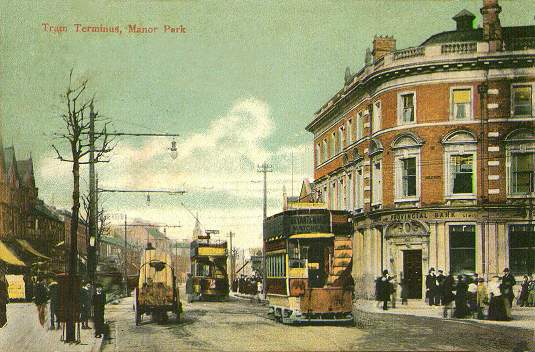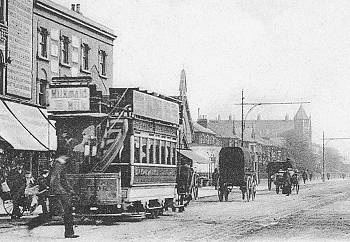

This postcard shows a horse tram of the North Metropolitan Tramways Company at its terminus at Manor Park in East London, with an electric tram of East Ham Corporation in the background. The route shown ran along Romford Road from Green Street, West Ham, and was the last one operated by the company. The card was in the "Local Views Series" published around 1906 by H. A. Nelson of East Ham (a stationers and tobacconists shop at 20 High Street), and most probably printed in Germany. Our example was posted on 26th July 1907 from Manor Park to an address in Montaubon, France. It looks as if the original photograph for this card had a horse in front of the tram, which the publisher has edited out so as to make his postcard look more modern, something which occurred on other similar horse tram views.
The small view (below) is an extract from an undivided back card by Stengel & Co of London, printed in Dresden, and posted on 24th March 1904. This is at the Princess Alice junction looking east on the final North Metropolitan route as shown in our main view. The scene can be accurately dated to early 1904 as the North Metropolitan horse tram is still in service, but the overhead is in place for the new West Ham electric trams from the Princess Alice to Green Street, which started on 5th October 1904.
The North Metropolitan Tramways was the largest horse car system in London and one of the most important in Britain, operating in the area to the north-east of the city. The first route opened on 9th May 1870 between Whitechapel Church and Bow Bridge, later being extended though to Aldgate in the west and to Stratford, Leytonstone and Manor Park in the east. The system expanded at a rapid rate into areas of Essex and Middlesex, and in 1891 took over the North London steam tramway, converting it to horse traction. After its acquisition by the London County Council in 1897, the operation of the London Street Tramways was transferred to the North Metropolitan. At its maximum the network was nearly 57 miles in length, operating over 700 horse trams with several thousand horses.
 The first five trams followed American practice, being double-deck cars of a standard design from John Stephenson & Co of New York. Further cars were added from Stephenson and also from Hughes & Co and Starbuck. In 1877 the company built a tram repair and building works at Union Road, Leytonstone, where from 1885 onwards they built not only cars for themselves, but also for other operators. In the beginning the horses were hired from the London General Omnibus Company, but after 1878 the company bought their own. The livery of the trams depended on the route they were operated on. The Romford Road route's cars were red and white.
The first five trams followed American practice, being double-deck cars of a standard design from John Stephenson & Co of New York. Further cars were added from Stephenson and also from Hughes & Co and Starbuck. In 1877 the company built a tram repair and building works at Union Road, Leytonstone, where from 1885 onwards they built not only cars for themselves, but also for other operators. In the beginning the horses were hired from the London General Omnibus Company, but after 1878 the company bought their own. The livery of the trams depended on the route they were operated on. The Romford Road route's cars were red and white.
When the London County Council came into being in 1889, one of its first declared policies was to take over and operate London's tramways using the 21-year purchase clauses of the 1870 Tramways Act. This they soon began to do. In 1892 the North Metropolitan lines became the focus of their attention, but although the lines within the LCC area were purchased as they became available despite the company's opposition, they were leased back to the company for them to operate for the time being until the LCC were in a position to own enough routes to take over full operation themselves. It was clear that the network would eventually become fragmented as electrification progressed, so in 1902 the Metropolitan Electric Tramways was formed to take over the lines in Middlesex. In 1903 West Ham Corporation bought the routes in their borough, followed in 1906 by Leyton Council. After that the only North Metropolitan tramway left was the section of the Romford Road route in East Ham as on our postcard. This East Ham Council agreed to purchase for £8,000, with the last horse tram running on 28th April 1908.
The North Metropolitan Tramways Company had been most innovative and forward thinking. Realising that horse operation was inefficient, they considered several forms of mechanical traction. In 1877 an early Merryweather steam tram was tested pulling a horse car on the Stratford to Leytonstone route, as indeed was a Beaumont compressed air locomotive in 1881. In 1882 a Faure accumulator car was tested at Union Road. During 1887 and early 1888, six Elieson battery locomotives pulled horse cars from Stratford to Manor Park. Finally, from 1889 to 1892 six leased Lorini accumulator cars successfully operated the isolated Canning Town to Plaistow route. They were only withdrawn because of the heavy wear they were causing to tram tracks built for horse traction. The keen interest shown by the company in electric traction suggests that had it not been for the unwanted acquisitive aspirations of the London County Council, mains-supplied electrification would have been tried by North Metropolitan and London may well have had true electric tramways some ten years earlier than actually happened.
![]() Go to Postcard Of The Month Index
Go to Postcard Of The Month Index